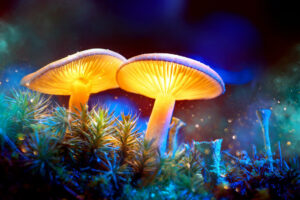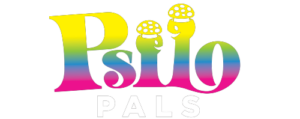Notable Elements
Historical Significance: Shrooms have a long history of use in therapy and spirituality, especially those with hallucinogenic properties.
Diverse Mushroom Ecosystem: Over 10,000 mushroom species play vital roles in ecosystems by breaking down organic matter and recycling nutrients.
Traditional Medicine: Mushrooms like Reishi, Shiitake, and Cordyceps have been used in Traditional Chinese Medicine (TCM) for health benefits.
Indigenous Use: Indigenous cultures, including Amazon tribes, use psychoactive mushrooms like Psilocybe cubensis in rituals.
Psychoactive Potential: Psilocybin in certain mushrooms shows promise in treating mood and anxiety disorders, often in combination with therapy.
Medicinal Non-Psychoactive Mushrooms: Mushrooms like Reishi, Shiitake, Cordyceps, and Turkey Tail offer health benefits through bioactive compounds.
Research Challenges: Researchers face obstacles like regulations, quality control, cultural stigma, and dosage precision in mushroom studies.
Dosage and Safety: Proper dosage, controlled environments, and the presence of a sober “sitter” are crucial for safe psilocybin use.
Legal Considerations: Psilocybin’s legality varies by location, requiring adherence to local regulations.
Future Medicine: Mushrooms hold potential as sources of effective medicines, both psychoactive and non-psychoactive, for various medical applications.
Introduction
The therapeutic and spiritual uses of shrooms a.k.a mushrooms date back thousands of years and are widespread throughout cultures due to their unique qualities, especially those of hallucinogenic mushrooms.
Medical properties of shrooms, including their possible utility in treating mental health issues, controlling pain, strengthening the immune system, and more, have only recently been the subject of scientific investigation. This essay will go into the varied mushroom ecosystems and the healing benefits they provide.
What do Mushrooms Mean?
The fungus kingdom includes the mushrooms we know and love. They are interesting to examine because of the ways in which they differ from both plants and animals. There are more than 10,000 species of shrooms known to science, and it’s probable that many more exist but have yet to be found.
The reproductive component of a mushroom is the cap, which is attached to the stem. They are important to ecosystem health because they decompose organic materials and recycle nutrients, and they may thrive in a wide range of habitats, from forests and grasslands to rotting wood.
Use of Mushrooms throughout History
Traditional medicine from many different cultures has long recognized the health benefits of psilopals. Among the most well-known are:
- Traditional Chinese Medicine
Reishi (Ganoderma lucidum), Shiitake (Lentinula edodes), and Cordyceps (Cordyceps sinensis) mushrooms, among others, have been utilized for millennia in TCM to improve health and extend life expectancy. In particular, Reishi has received the moniker “mushroom of immortality” because of its purportedly life-extending properties.
- The Original Cultures
As a result of its hallucinogenic effects, indigenous people all over the globe, including those living in the Amazon rainforest, have traditionally employed psychoactive mushrooms like Psilocybe cubensis in religious and shamanic rites.
- Shamanism in Siberia
The Amanita muscaria mushroom has been used by shamans in Siberia for centuries to facilitate visions and communicate with the afterlife.
Psychoactive Mushrooms and Their Medicinal Potential

Psilocybin and psilocin, two chemicals found in certain psychoactive mushrooms, have attracted a lot of interest for their possible therapeutic uses in recent years. Therapeutic studies including these drugs have shown encouraging results, particularly in the treatment of mental health issues.
- Psilocybin for Mood and Anxiety Disorders
Psilocybin, which may be extracted from “magic mushrooms” (Psilocybe spp. ), has been studied for its possible efficacy in treating mood and anxiety problems. Studies have shown that a single dosage of psilocybin may lead to large and long-lasting decreases in depression symptoms when delivered in a controlled setting.
- Therapeutic Use of Psychedelics
The use of psychedelics like psilocybin in combination with traditional talk therapy is being researched as a potential new method for alleviating the symptoms of mental illness. During therapy, patients are typically led through deep introspective experiences that might aid in the processing of painful memories or destructive thinking patterns.
- Possible Modes of Operation
While the precise processes by which psilocybin exerts its therapeutic benefits remain unclear, they are speculated to entail shifts in neuronal plasticity, enhanced connectivity, and altered serotonin signaling. This is still a topic of active study.
- Security and Laws
Psilocybin has promising therapeutic potential, but it should be used only under the supervision of qualified specialists in a secure setting. The regulatory framework for these compounds is still being debated, and their legal status varies widely around the globe.
Medicinal Mushrooms Beyond Psychedelics
There is a large range of non-psychoactive mushrooms that have demonstrated promising medical effects, in addition to the few that are really psychoactive. The bioactive chemicals found in many types of mushrooms have been shown to have beneficial effects on human health.
- Reishi
In TCM, reishi mushrooms are prized for their ability to strengthen resistance to infection, lower inflammation, and promote general health. They include a wide variety of bioactive chemicals, including polysaccharides, triterpenes, and others.
- Lentinula edodes (shiitake)
The flavor and health advantages of shiitake mushrooms are well-known. Compounds like lentinan, which has been shown to have anti-cancer and immune-enhancing effects, may be found there.
- Cordyceps sinensis (Cordyceps):
Cordyceps are fungus that feed off of insects as a parasite. They are used to increase vitality and stamina in traditional Chinese medicine. Athletes use cordyceps pills because of their ability to boost performance.
- Trametes versicolor (Turkey Tail)
Polysaccharopeptides (PSP) and beta-glucans, found in turkey tail mushrooms, may help regulate the immune system. Evidence from studies shows they might be helpful in the fight against and treatment of cancer.
Challenges in Medicinal Mushroom Research

There is a rising interest in the therapeutic potential of mushrooms, but researchers face a number of obstacles when trying to put their discoveries into practice.
- Restrictive Regulations
It is challenging to conduct clinical studies and get access to these medicines because of the inconsistent legal status of many medicinal mushrooms and their bioactive ingredients.
- Controlling and standardizing quality
Due to differences in growth conditions and extraction techniques, it might be difficult to guarantee the consistency and quality of goods based on mushrooms, such as supplements or extracts.
- Aspects of Culture and Stigma
Stigmatization due to misconceptions about the psychotropic effects of some mushrooms might impede research into and recognition of their potential medicinal advantages
Dosage and Administration of Psilocybin
Psilocybin, a hallucinogenic chemical present in several psychedelic mushroom species, may have medicinal use. It is important to note that psilocybin should only be taken in a safe and supervised environment, preferably with the help of knowledgeable individuals. Here is a comprehensive look at how much to take and how to give it to yourself:
Dosage
- Differences between people
Due to variables including body weight, metabolism, and individual sensitivity, the optimal dose of psilocybin might vary greatly from person to person. There is no universally accepted dosage for psychedelics; beginning users, in particular, should begin with a low dose and gradually increase it.
- Normal Dosage Variations
Psilocybin is commonly administered at a dose of 1–25 milligrams per kilogram of body weight in clinical and research settings. This equates to anywhere between 70 and 1,750 milligrams for a person weighing 70 kilograms (154 pounds). However, smaller dosages are often used to lessen the impact.
- Limiting Dose
The minimum quantity of psilocybin necessary to induce observable effects is called a threshold dosage. This is typically between 0.2 and 0.5 grams of dry psilocybin-containing mushrooms for a person. Subtle changes in perception and disposition may be induced at threshold dosages.
- Common Dosage
One to three grams of dry mushrooms, or around 10 to 30 milligrams of psilocybin, is considered a moderate or typical dosage. This is often where those who want to have a more deep psychedelic experience begin.
- Extreme Dose
Three to five grams of dried mushrooms (equal to thirty to fifty milligrams of psilocybin or greater) is considered a high dosage, generally utilized in therapeutic or spiritual situations. When taken in large quantities, psychedelic effects tend to be powerful and pervasive.
Also Read : Dosage Ranges for Magic Mushroom Consumption
Administration
- Environment controlled
Safe and regulated conditions are required for psilocybin administration, which is why this drug is often referred to as “set and setting.” A relaxing, peaceful, and undisrupted environment is ideal. Having a reliable and knowledgeable guide or therapist present is crucial.
- Sessions with a Guide
In a guided psychotherapy session, psilocybin is often used. A therapist or guide may assist people through this by being there to listen and provide encouragement and advice as required. In order to maximize advantages and guarantee psychological safety, this therapeutic method is crucial.
- Planning and Coordination
Individuals will often have pre-session planning meetings to establish goals and go through expectations. There is a time of integration after an event, during which the lessons learned might be worked into one’s routine.
- Way of Ingestion
Some people like to prepare tea or tinctures out of psilocybin, while others find it more convenient to ingest dry mushrooms. The intensity and length of an experience might vary depending on how it is consumed.
- Duration
Psilocybin’s effects may endure for many hours, with the peak being between two and three hours after intake. People need to pack for the long haul and make sure they have somewhere secure to stay.
- Taking the Law into Account
Psilocybin’s legal status differs from one location to the next. Depending on the jurisdiction, it may be illegal in most cases but allowed for medical use only in others. Recognizing and adhering to all applicable local rules and regulations is of the utmost importance.
- Cautionary Measures
Psilocybin is known to cause shifts in perspective, new ways of thinking, and a dissolution of self-consciousness. In order to guarantee the safety of both the participant and the experimenter, it is recommended that a sober and knowledgeable person (a “sitter”) be present.
Conclusion
Mushrooms have significant potential as a new source of effective medicines due to the wide variety of species and bioactive substances they contain. These fungi have much to offer in the field of medicine, from psychoactive mushrooms like Psilocybe spp., which show promise in treating mental health issues, to non-psychoactive mushrooms like Reishi, Shiitake, and Cordyceps, which provide immune-boosting and other health advantages.

Hi! I’m Jacob Hawthorne, a passionate medical student dedicated to exploring the fascinating world of psychedelics, particularly magic mushrooms (commonly known as shrooms). With a deep interest in their therapeutic potential and profound effects on the human mind, I aim to provide accurate and evidence-based information about shrooms in the Canadian context.

